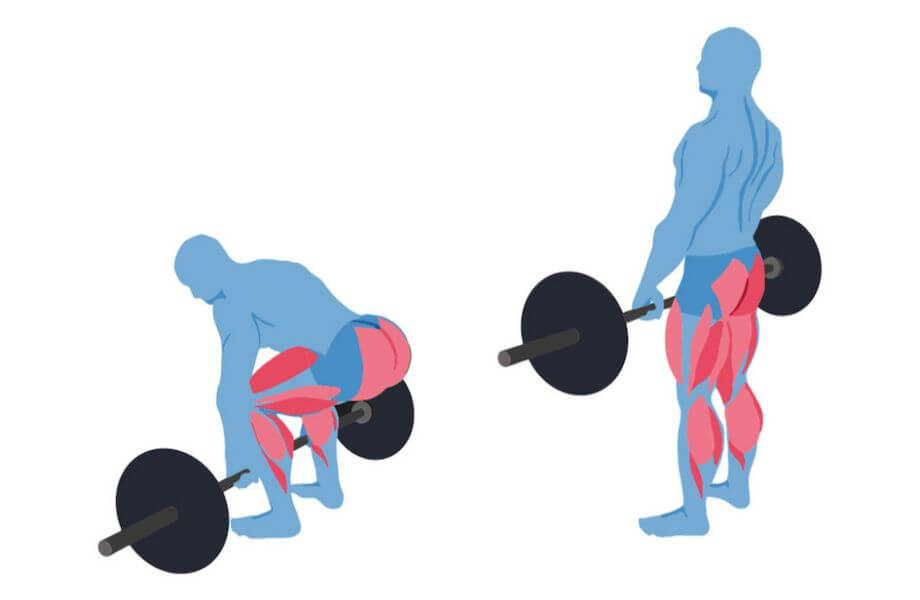We test and review fitness products based on an independent, multi-point methodology. If you use our links to purchase something, we may earn a commission. Read our disclosures.
The deadlift is a primal movement pattern—hinging at the hips and lifting an object off the ground is as functional as it gets, and humans have been doing it since the beginning of time. Although the deadlift appears to be straightforward, it’s a complex movement because so many different muscles have to engage to do it well.
The deadlift is the one of the best back exercises—but it’s not just your upper back that’s targeted. The deadlift is a compound exercise that involves the entire backside of your body—the “posterior chain,” in exercise-science speak.
8 Deadlift Muscles Worked
Curious to know what muscles deadlifts work?
Deadlift muscles worked include most of the body, TBH.
- Hamstrings
- Glutes
- Quads
- Calves
- Lats
- Traps
- Erector spinae (the muscles that run alongside your spine and keep you upright)
- Abdominals
Diving deeper, research surprisingly shows that the erector spinae and quads show more muscle activation than the gluteus maximus and hamstrings during a deadlift. And within the hamstrings themselves, the semitendinosus muscle (in the middle) is slightly more activated than the biceps femoris (on the outer side) during the movement.
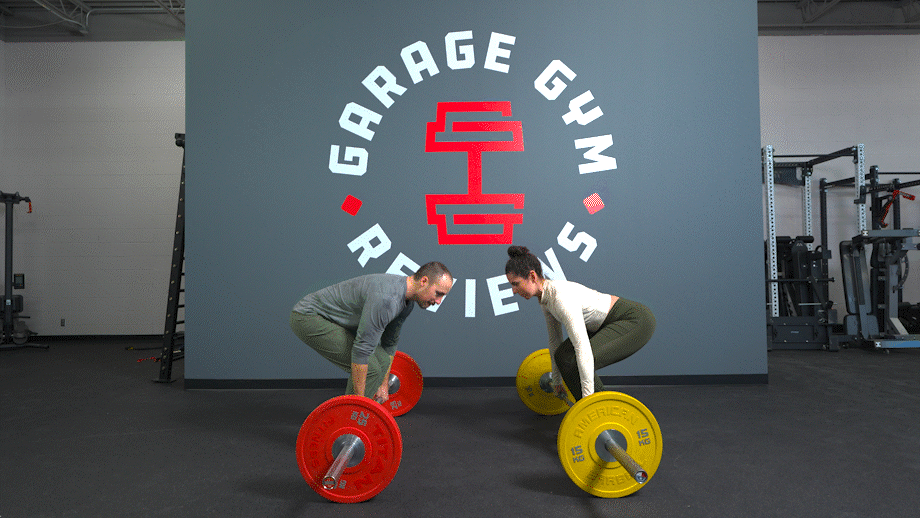
Some say the deadlift can be used as the ultimate test of strength, and we don’t disagree. It’s the culmination of lower body power paired with back strength. If that’s not a full-body feat of strength, then what is?
Deadlift Benefits
One of the main benefits of the deadlift is how efficient this one movement is at recruiting everything on the backside of your body, from your calves to your traps, all at once. When thinking about strength training, it’s also a practical movement to train.
“In terms of functionality, deadlifting is probably the most important lift,” explains Greg Panora, seven all-time world record holder in the sport of powerlifting who got his start 20 years ago at the renowned Westside Barbell under Louie Simmons. “We should all be good at picking up weight off the floor.”
The deadlift is hip-dominant exercise, requiring the most activation from the legs by way of the quads, hamstrings, and glutes. However, to perform the deadlift correctly, and protect your back, the muscles in your upper body have to stabilize the entire length of the spine and the shoulder joints so the legs can do the work of pulling the bar off the floor. This makes the deadlift a staple for building a strong backside.
How To Warm Up For A Deadlift
The way you warm up for deadlifts will vary depending on the day and your individual needs. It’s safe to say that the deadlift will require some amount of warm up due to the fact so many muscle groups will be required to fire during the lift.
Kate Meier—a USA Weightlifting L1 Coach and head of content here at GGR—suggests a few movements before the deadlift: cherry pickers, banded marches, glute bridges, good mornings, and side planks. Your warm up is also a great chance for soft tissue work with a foam roller or massage gun on tight or sore muscles.
How To Deadlift
Panora, who now coaches a team of powerlifters online and at CrossFit Casco Bay in Maine, says the conventional deadlift is straightforward. He reports coaching the deadlift with a military cadence. “Conventional pulls go like this: grab the bar; pull your scapulas back and down; straighten your legs to create the stretch reflex; drive your legs into the bar; then pull the bar back into your body.”
It sounds simple, right? Let’s dive into the mechanics of proper deadlift form a bit more.
- To perform a deadlift, assume the starting position: Standing with your feet hip-width apart, the barbell should be positioned over the middle of your deadlift shoes, close to the shins. From this position, hinge at the hips until you can grab the bar and plant your hands in an overhand grip slightly wider than shoulder-width apart.
- Next, let your knees bend and push your shins toward the barbell. Now it’s time to lock in your upper body: Keeping your back straight, pull the shoulder blades back and down via your rhomboids, as if you could pull the shoulder blades into your back pockets. Keep your arms straight.
- Take a breath in and brace your core. To initiate the lift, start generating force from the floor by pushing into your heels. Without pulling with your upper body, use your legs and glutes to push the hips forward, rising to stand in an upright position. Keep the bar close to your legs (grazing the shins and quads during the lift) to keep the load close to your body.
- The final position is an upright body with full hip extension. This lockout position at the top requires a strong glute squeeze while keeping the spine neutral.
- To put the bar down, send your hips back, like you’re going to sit down in a chair, and control the weight until the barbell reaches the floor.
How Many Deadlifts Should You Do?
The amount of repetitions performed for a novice lifter is going to be different for someone with weightlifting experience under their belt. In either case, following a program or connecting with a personal trainer can help guide you on the right path for you and your specific goals.
If your goal is to improve strength—including grip strength—and progress the weight on the deadlift bar, you’ll be performing lower reps to allow for heavier loads. If your goal is more about learning the deadlift or building muscle mass, your repetitions will be higher with lighter loads to allow for the appropriate amount of volume.
The National Strength and Conditioning Association uses the table below to outline recommended repetitions. This table is based on your estimated one-rep max on deadlift. Even if you don’t know your one-rep max, the chart will give you a good estimation.
| Percent of Est. 1-Rep Max | Repetitions Allowed |
| 60-70% | 10-15 reps |
| 70-80% | 8-10 reps |
| 80-90% | 4-8 reps |
| 90-95% | 2-4 reps |
| 95-100% | 1-2 reps |
When taking into account your goals, the number of sets will change as well. For strength, 1 to 5 sets is appropriate since you’ll be lifting close to your one-rep max. For muscle mass, working in the 3-to-6 set range is ideal since you’ll be lifting at 60 to 70% of your one-rep max.
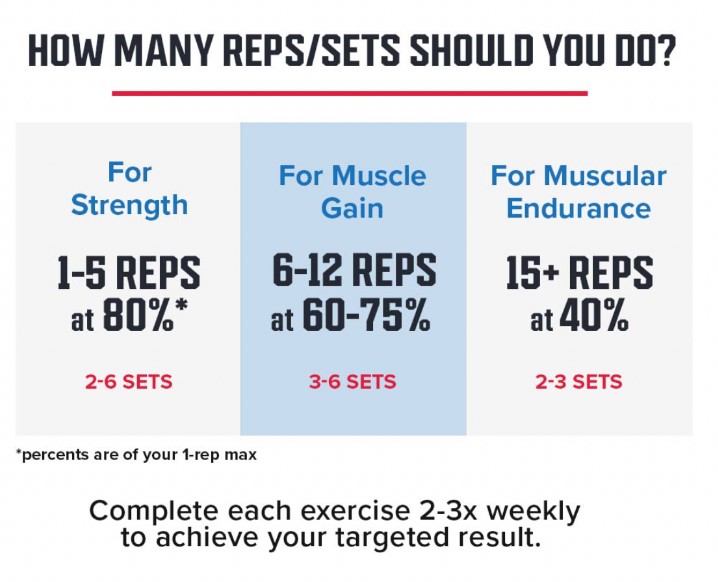
Deadlift Variations
Deadlifts—much like the other two exercises that make up the “big three” barbell lifts (squat, bench press, deadlift)—can be performed in a variety of ways. The deadlift is a hip hinge that works primarily the hamstrings and glutes. However, the deadlift works the back muscles as well, requiring stability from the lats, traps, and erector spinae to maintain a neutral spine. Deadlift variations exist to stimulate the muscles through a variety of different ranges of motion, with different weight and reps. Here are just a few to consider:
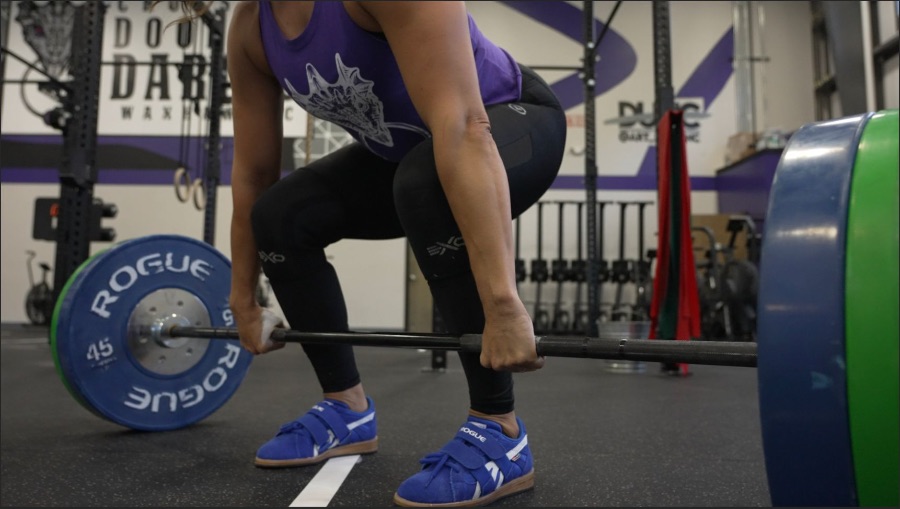
Barbell Deadlift
The barbell deadlift can be performed in a standard hip-width stance or a wide sumo stance. Practicing the barbell deadlift from the floor, through the full range of motion, is the most standard way to perform the deadlift.
Trap Deadlift
A trap bar is recognizable by its hexagonal shape, which is why you’ll also hear it referred to as a hex bar. You stand inside the hexagon and grip the neutral handlebars. Trap deadlifts work your hamstrings and glutes like a straight bar deadlift, however, research shows that it puts less strain on the lower back than a barbell deadlift. The movement looks a little more squat-like, but is ultimately still a hip hinge.
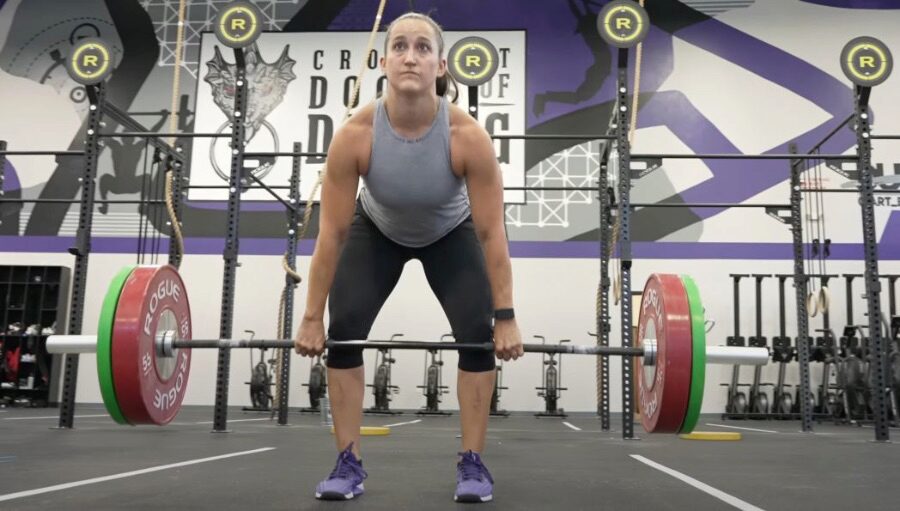
Romanian Deadlifts (RDL)
We love the RDL for practicing the hip hinge and working the hamstrings, glutes, and core. The movement starts in the standing position and you will lower the weight just below your knees, not bringing the weight through full range of motion. Because you won’t put the weight down and reset your movement, the core stays fired to keep the back flat and braced.
Dumbbell & Kettlebell Deadlifts
The dumbbell and kettlebell deadlifts are great ways to perform the hip hinge with a lighter load and master the movement pattern. Depending on the weight and your hamstring flexibility, you may be bringing your hips through full range of motion, putting the weight back on the floor and resetting. Dumbbells and kettlebells are also great for performing a partial range of motion, like an RDL.
Single-Leg Deadlifts
Single-leg deadlifts not only challenge your hamstrings and glutes, they also engage your core because it requires so much balance. The single-leg deadlift can be performed with your own body weight, or a dumbbell, kettlebell, or a barbell once you’ve mastered the movement. We recommend starting with bodyweight and placing your hand on a wall, tall box, or dowel for stability.
Stiff Leg Deadlift
In the stiff leg deadlift, you’ll use a light to moderate weight, performing the hip hinge movement, but keeping the legs straight throughout the movement. This will put more of a stretch on the hamstrings. The stiff leg deadlift is similar to the RDL in that you’ll start in the same position, standing straight and gripping the barbell. The main difference between the RDL and the stiff leg deadlift is that you’ll work the hamstrings through a larger range of motion.
Deficit Deadlift
A deficit deadlift is performed while standing on a slightly elevated surface, like a large weight plate, and running through the movement. By doing this, you’ll increase your range of motion, which can help increase strength. Aim for a surface that’s a maximum of 4 inches tall to perform a deficit deadlift.
Deadlift Alternatives
The deadlift is a versatile movement, allowing you to change weight, repetitions, range of motion, tempo, etc. However, throughout the lifetime of your lifting career, you may want to venture away from the deadlift—perhaps for an injury or the need for novelty—but still want the ability to strengthen the hamstrings, glutes, and back.
Hamstring-dominant alternatives for the deadlift include the kettlebell swing, glute bridges, cable pull throughs, good mornings, and the reverse hyper. Back-dominant alternatives include the bent over row, back extension, and farmer’s carry.
Sumo Versus Conventional Deadlifts
The sumo deadlift is essentially a wide-stance deadlift. With feet wide and toes pointed out, arms grip the bar inside of the foot stance and the torso adopts a much more upright position.
What muscles do sumo deadlifts work? The sumo deadlift is popular among powerlifters because it shortens the distance of the bar path, relies more on quadriceps and adductors (in addition to hamstrings), and is typically less taxing on the back.
So when do you pull conventional and when do you do sumo? It depends on your individual goals, hip mobility, and hamstring flexibility.
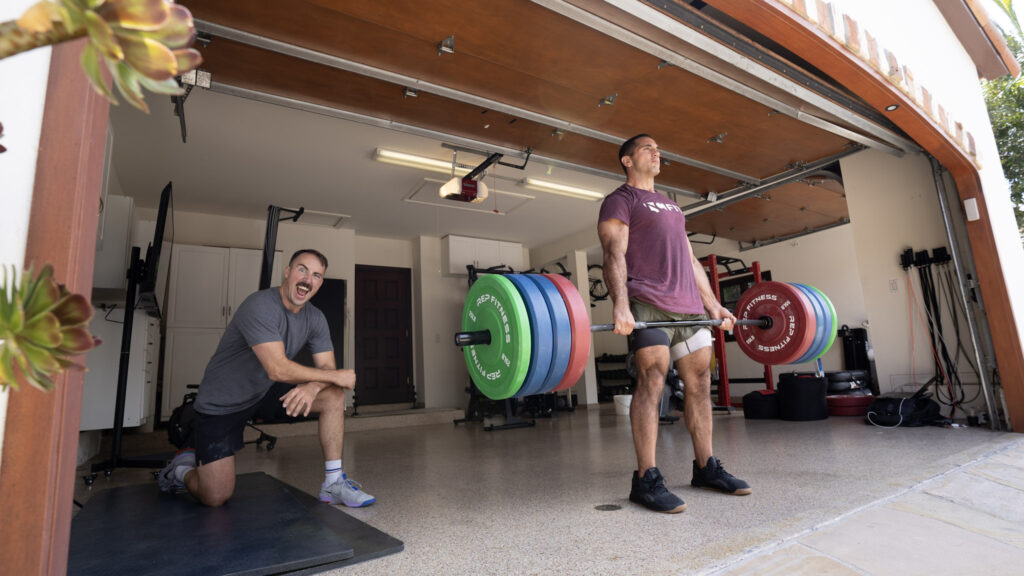
Common Deadlift Mistakes To Avoid
According to Panora, a common mistake he sees—from beginners to elite powerlifters—is neglecting the correct scapula position.
“[Our team] had two 2,000-pound totallers tear their biceps deadlifting,” he says. “If you’re pulling your scapulas down [in the correct position], then bending your arm is impossible.”
Improper positioning of your shoulder blades and upper back can produce a ripple effect of other issues including back rounding, excessive pulling from the arms, and not starting with enough weight on the heels. Other common deadlift mistakes include incorrect hip positioning, and pulling with your upper body instead of pushing with your lower body.
Proper form is crucial for the deadlift—incorrect form can increase your risk of injury, including lumbar, or lower back, pain.
Final Verdict
Here is what we want you to know about the deadlift: It’s the ultimate full-body strengthening tool. It will help you build a strong back and absolutely diesel legs. There is a variation to suit your needs and your goals. We recommend the novice lifter start with light weights. Hiring a coach or having a buddy around for a form check is never a bad idea!
What Muscles Do Deadlifts Work FAQs
Can beginners deadlift?
New lifters can benefit from starting with kettlebell or dumbbell deadlifts to practice the hip hinge, then graduating to a light trap bar or barbell deadlift once the hinge has been mastered. We encourage beginners to have a trainer or buddy with you to check the form.
What are the benefits of the deadlift?
Benefits are many, but straightforward: The deadlift is the ultimate way to strengthen the entire backside with one movement. The deadlift benefits your hamstrings, gluteus maximus, latissimus dorsi, erector spinae, and trapezius muscles. The deadlift can benefit lifters with light or heavy loads, through full range of motion or partial, with a narrow or wide stance. It’s also versatile and can be modified to meet your needs and the equipment you have at home.
How to warm up for a deadlift?
Warming up for the deadlift is an individual experience that will vary for each lifter. You may find your warm up needs also differ from week to week. We suggest activating glutes with bridges before you start repping out barbell sets. Goblet squats and bird dogs are also a great way to get the hips primed up and the core stable.
What muscles do deadlifts work?
The deadlift is a compound lift that works the entire posterior chain, or the muscles on the backside of your body. This includes the calves, hamstrings, glutes, lats, traps, and erector spinae. It will also target your core, including your obliques and rectus abdominis.
Further reading

Trying to decide if working on a treadmill desk is right for you? Check out what the experts have to say about this popular piece of equipment. Read more

The side plank exercise is a great way to strengthen your obliques and build a stable core. Learn the proper form and more from a certified personal trainer. Read more

A registered dietitian goes over what exactly a detox is, if it is necessary for weight loss and how to detox your body safely Read more

Lalo is a company who is making shoes for Special Forces Operation Members that also work for the general population. The Zodiac Recon Shoes are a highly cushioned running shoe that are great for just about any environment. Read more

